7 Feb 2017
Good posture. We’ve all heard those words time and again from our coaches. Hold your arms out straight, keep your chin up, don’t round your shoulders, stop slouching. “Yes, coach I know, I’m trying, but I’m never going to look like Sasha Cohen.”
Both as a coach and an observer, my eyes gravitate to the skaters with a straight back, shoulder level arms, eyes and head up. These qualities create a pleasing line, and to me, it makes the skater exude confidence. Besides looking nice, good posture will ultimately lead a skater to have good technique, as proper postural alignment is a key factor in a skater’s ability to maintain the proper axis of rotation in a jump.
One’s posture is affected by several things, including spinal mobility and alignment, muscle symmetry, strength, and flexibility. It is not typical for a skater to possess all of the qualities needed for proper posture naturally; therefore, posture is something that can be worked on and improved with the right exercise routine. A skater with good spinal alignment will have an easier time maintaining good postural alignment then a skater with poor spinal alignment and curvature.
The Spine
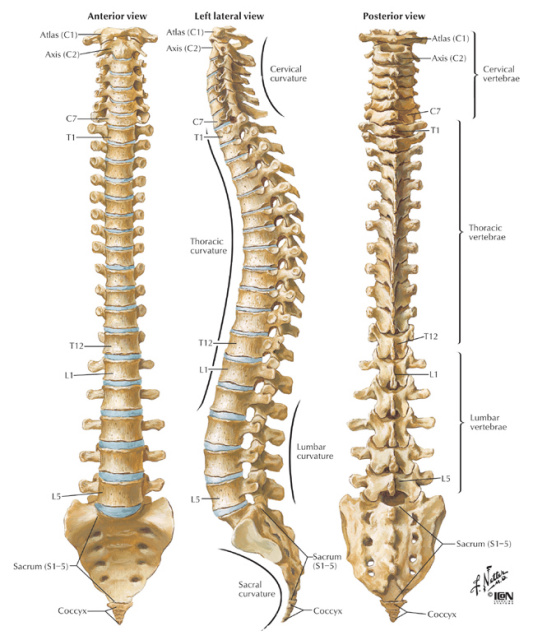 This picture includes views of the spine anteriorly, from the side, and posteriorly. The spine is divided into several sections. The top seven vertebrae make up the cervical spine, and include the vertebrae in the neck. The next twelve vertebrae make up the thoracic spine, or the mid-back. The bottom five separate vertebrae are the lumbar spine, or lower back. Finally, your sacrum, also known as the tailbone, consists of five fused vertebrae below the lumbar vertebrae. This picture includes views of the spine anteriorly, from the side, and posteriorly. The spine is divided into several sections. The top seven vertebrae make up the cervical spine, and include the vertebrae in the neck. The next twelve vertebrae make up the thoracic spine, or the mid-back. The bottom five separate vertebrae are the lumbar spine, or lower back. Finally, your sacrum, also known as the tailbone, consists of five fused vertebrae below the lumbar vertebrae.
In the middle image, you can see that the spine makes a ‘double S’ type curve. Each section of the spine has a natural bend to it, and the opposing nature of the bends, or curves, balance each other out. If the curves fall into a normal angle range, you can draw a straight line from the first cervical vertebrae to the bottom lumbar vertebrae. This ‘vertical line’ can be a key factor to attaining good posture. Any deviation from this alignment will make it more difficult for a skater to achieve proper postural alignment.
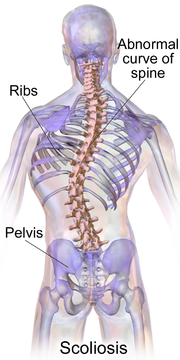
From the anterior and posterior views (left and right images), the spine should make a completely vertical line from the top to the bottom. Any deviation from this vertical line can be classified as scoliosis, or a precursor to scoliosis. A scoliotic curve will be viewed as a curve that bows to either the right or left, at any level of the spine. Most scoliotic curves occur in the thoracic to upper lumbar area. As you can see in the scoliosis picture, the curvature can affect the alignment and positioning of the ribcage and the pelvis.
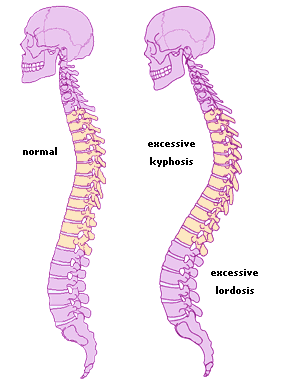 An excessive bend of the thoracic spine is called a kyphosis, and presents as a rounded upper back. Kyphotic posture can cause the shoulders to round forward and the shoulder blades to angle forward. Notice in the picture that the head and chin point downward as a result of the kyphosis. An excessive rounding of the lumbar spine is called a lordosis. An excessive lordosis, when not accompanied by a thoracic kyphosis, can cause the pelvis to tilt forward. Typically, over time, one curve can influence the other, as the spine develops compensations to ‘balance the spinal alignment’, attempting to maintain that vertical line from the first cervical vertebrae to the last lumbar. An excessive bend of the thoracic spine is called a kyphosis, and presents as a rounded upper back. Kyphotic posture can cause the shoulders to round forward and the shoulder blades to angle forward. Notice in the picture that the head and chin point downward as a result of the kyphosis. An excessive rounding of the lumbar spine is called a lordosis. An excessive lordosis, when not accompanied by a thoracic kyphosis, can cause the pelvis to tilt forward. Typically, over time, one curve can influence the other, as the spine develops compensations to ‘balance the spinal alignment’, attempting to maintain that vertical line from the first cervical vertebrae to the last lumbar.
Spinal mobility can also influence a skater’s ability to stand and sit straight with proper alignment. Each vertebrae in the spine has a certain amount of ‘spring’, or mobility to it. With pressure applied to it, each segment should glide forward to a certain degree. This mobility allows each segment to move freely in all directions: flexion, extension, side bend, and rotation. If a skater has stiffness in some vertebral segments, specifically in the thoracic spine, it will affect the skater’s ability extend from the thoracic spine and maintain a vertical line. There are many exercises that a skater can use to improve thoracic mobility and self mobilize the thoracic spine, most notably using a foam roll.
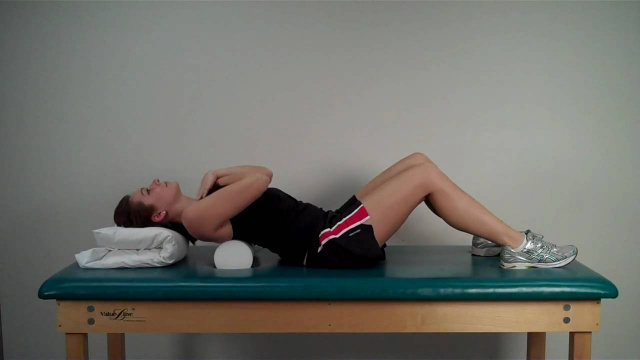
Strength
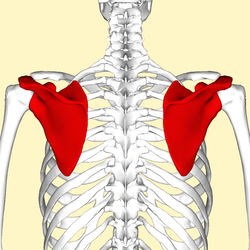 Strength in the muscles that keep the scapulae (shoulder blades) in the proper position is very important to maintain good posture. The scapulae are part of the shoulder joint and rest in a vertical position against the rib cage. Many muscles attach to the scapula, but the strength of the middle and lower trapezius, and the rhomboid muscle is imperative to achieving the proper scapular position. Each of these muscles originates on the thoracic spine, and attach to the medial side of the scapula. Strength in these muscles keeps the scapulae in the correct position against the ribcage. Weakness can lead to scapular protraction or winging, in which the scapula slides forward and angles downward on the ribcage. This results in a forward sloping of the shoulders, as seen in right side image in the following picture. Strength in the muscles that keep the scapulae (shoulder blades) in the proper position is very important to maintain good posture. The scapulae are part of the shoulder joint and rest in a vertical position against the rib cage. Many muscles attach to the scapula, but the strength of the middle and lower trapezius, and the rhomboid muscle is imperative to achieving the proper scapular position. Each of these muscles originates on the thoracic spine, and attach to the medial side of the scapula. Strength in these muscles keeps the scapulae in the correct position against the ribcage. Weakness can lead to scapular protraction or winging, in which the scapula slides forward and angles downward on the ribcage. This results in a forward sloping of the shoulders, as seen in right side image in the following picture.
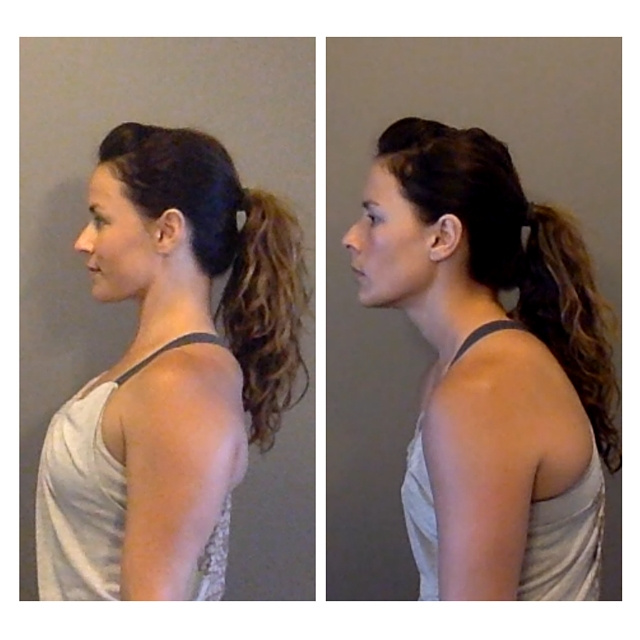
There are many ways to strengthen the lower and middle trapezius, and the rhomboids, with my favorite being the I,T, and Y exercise done of the floor, ball, or weight bench.
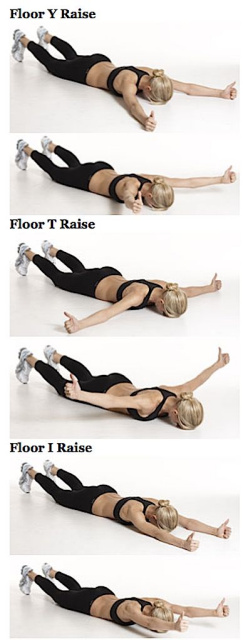

Core strength is also important to help maintain proper posture. The core musculature includes your abdominal and paraspinal muscles, which work together to stabilize the trunk. Without sufficient core strength, a skater lacks the trunk support to complete many different skating moves. Weak core musculature can lead to slouching, bending at the waist, and inability to extend from the spine. The paraspinal muscles, which run the length of the spine, help to hold the trunk up against gravity, especially in camel spins and spirals. They also work in conjunction with the glute muscles to stabilize the trunk while extending the hip (think basic stroking). During stroking, a skater with a weak core will break at the waist, causing the glute muscles to become insufficient, affecting the skater’s ability to extend from the hip during push-off.
Flexibility
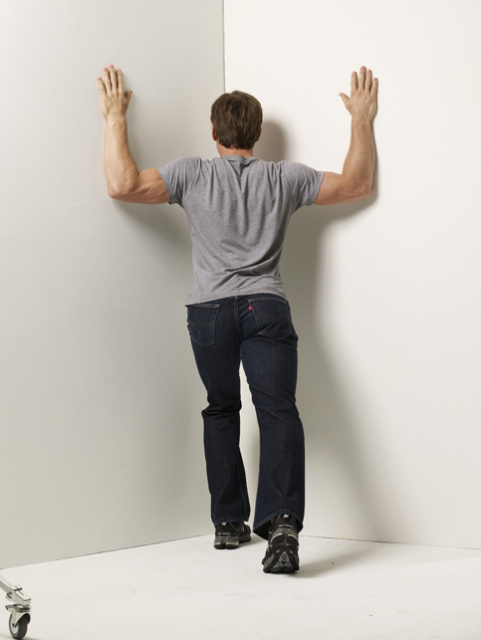
There are several muscles whose flexibility will affect a skater’s posture. In the upper extremity, three muscles of note are the pectoralis major, upper trapezius, and levator scapula. The pectoralis major is your chest muscle that, if tight, can result in forward sloping or rounding of the shoulders. It can easily be stretched in a corner or a doorway, such as in this picture.
The upper trapezius and levator scapula muscles run from the cervical spine (neck) to the top of the shoulder blade. Tightness in these muscles can pull the scapulae forward and can contribute to a rounding of the shoulders. Image number 1 shows a way to stretch the upper trap, and image number 2 demonstrates a levator scapula stretch. In the upper trap stretch, turn your head towards the arm that is raised, and bring the chin towards the armpit. In the levator scapula stretch, look away from the arm that is raised, and bring the chin towards the armpit.
1. 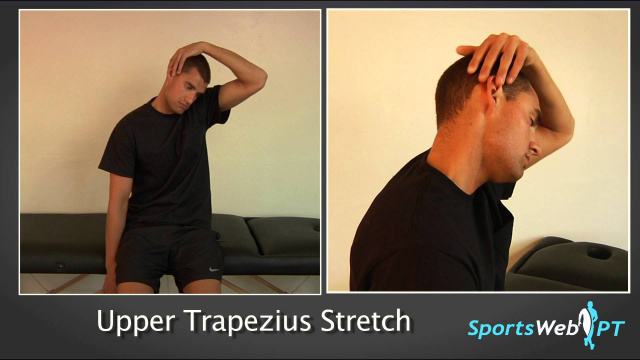 2. 2. 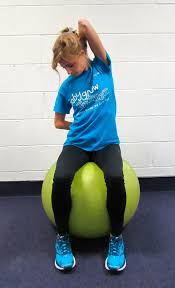
In conclusion, proper posture is affected by many factors. By addressing mobility, flexibility, and strength deficits, better posture is easily attainable. It just takes work!
Lauren Downes MSPT
|